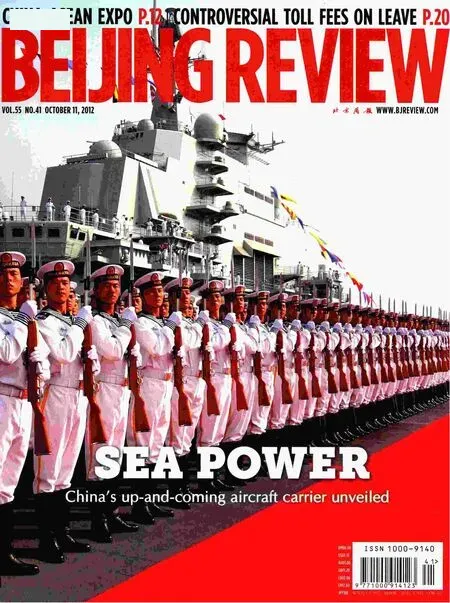Cradle for a Stronger Navy
Cradle for a Stronger Navy
With the Liaoning, China’s first aircraft carrier recently handed over to the People’s Liberation Army (PLA) Navy, the long-standing goal of the Chinese navy from the late 1920s has fnally come true, much to the joy and fulfillment of in-service and old-generation naval personnel and the people of China.
More than 80 years ago, the then-ruling Kuomintang first put forth plans to modernize the nation’s naval force, including manufacturing aircraft carriers, just a decade after the British launched the world’s frst functional aircraft carrier the HMS Hermes. But as China then suffered from both civil war and foreign aggression, and its economy was plagued with a frail industrial base, vulnerable farming and financial constraints, this grand plan remained only a fantasy.
The desire to build a strong navy is well-founded. China boasts large territorial waters, with four seas lying along its eastern continental shelves—the Bohai Sea, the Yellow Sea, the East China Sea and the South China Sea—covering a total of 3 million square km and a combined coastline of 18,000 km. China needs to defend its territorial sovereignty and maritime interests with a strong naval force. Moreover, the country was repeatedly invaded and bullied by foreign powers from the sea since the mid-19th century, resulting in its ceding of territories and payment of indemnities. At least twice, the Chinese navy suffered major defeats with Japan—once during the Sino-Japanese War of 1894-95, and again in the battle on the Yangtze River by Jiangyin, east China’s Jiangsu Province, in 1937. Naturally, these setbacks aroused the entire nation’s conviction to consolidate the naval defense system.
China’s humiliating modern history has taught us a hard lesson: A weak and backward country is likely to be beaten down. Considering its bitter past experience, it is well justifed for China to put the Liaoning to use in an effort to build up a strong naval force.
The launch and service of the Liaoning aircraft carrier is counted as one of the latest steps to further strengthen the country’s navy. As the aircraft carrier is largely intended for training and research purposes, it could well be the cradle for raising a more modernized naval feet with greater combat effectiveness.
A modern aircraft carrier is largely seen as the symbol of a strong navy and a nation’s comprehensive power. Of the fve permanent members of the United Nations Security Council, China is the last to acquire an aircraft carrier. While the country will not employ the giant vessel to intimidate other countries or police international waters, it will nonetheless help boost the prestige of the PLA and the Chinese nation.
WRITE TO US
Send an e-mail: contact@bjreview.com.cn
Please provide your name and address along with your submissions. Submissions may be edited.
北京周报 英文版 2012年 第41期 ISSN 1000-9140 广告许可证 0171号
北京市期刊登记证第733号 邮发代号2-922·国内统一刊号:CN11-1576/G2 国内零售价:人民币6.00元
CHINA......RMB6.00 U.S.A.......USD1.70 AUSTRALIA......AUD3.00 UK......GBP1.20 CANADA......CAD2.60 SWITZERLAND......CHF2.60
JAPAN......JPY188 EUROPE......EURO1.90 TURKEY......YTL5.00 HK......HKD9.30 NEPAL......RS40

